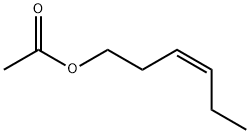A4684212
cis-3-Hexenyl acetate , 98% , 3681-71-8
Synonym(s):
(3Z)-3-Hexen-1-ol acetate;(3Z)-C-3-Hexenyl acetate;Leaf acetate
CAS NO.:3681-71-8
Empirical Formula: C8H14O2
Molecular Weight: 142.2
MDL number: MFCD00036563
EINECS: 222-960-1
| Pack Size | Price | Stock | Quantity |
| 25ML | RMB91.20 | In Stock |
|
| 100ML | RMB302.40 | In Stock |
|
| 500ML | RMB1303.20 | In Stock |
|
| others | Enquire |
Update time: 2022-07-08
PRODUCT Properties
| Boiling point: | 75-76 °C23 mm Hg(lit.) |
| Density | 0.897 g/mL at 25 °C(lit.) |
| vapor pressure | 2.14hPa at 25℃ |
| FEMA | 3171 | CIS-3-HEXEN-1-YL ACETATE |
| refractive index | n |
| Flash point: | 135 °F |
| storage temp. | Inert atmosphere,Room Temperature |
| color | Colorless to Almost colorless |
| Odor | at 10.00 % in dipropylene glycol. fresh green sweet fruity banana apple grassy |
| Odor Type | green |
| biological source | synthetic |
| Water Solubility | 1.11g/L at 20℃ |
| JECFA Number | 134 |
| BRN | 1721854 |
| Cosmetics Ingredients Functions | FRAGRANCE PERFUMING FLAVOURING |
| LogP | 2.7 at 30℃ |
| CAS DataBase Reference | 3681-71-8(CAS DataBase Reference) |
| NIST Chemistry Reference | 3-Hexen-1-ol, acetate, (Z)-(3681-71-8) |
| EPA Substance Registry System | 3-Hexen-1-ol, acetate, (3Z)- (3681-71-8) |
Description and Uses
cis-3-Hexen-1 -y 1-acetate has a powerful green, floral note reminiscent of banana. It may be prepared by acetylation of the corresponding alcohol.
Leaf Acetate increased leaf-feeding herbivores’ egg predation rates by a generalist predator. As a consequence, a plant could reduce the number of herbivores by more than 90% by releasing volatiles.
Safety
| Symbol(GHS) |  GHS02 |
| Signal word | Warning |
| Hazard statements | H226 |
| Precautionary statements | P210-P233-P240-P241-P242-P243 |
| Risk Statements | 36/38-10 |
| Safety Statements | 26-36-24/25 |
| RIDADR | UN 3272 3/PG 3 |
| WGK Germany | 2 |
| RTECS | MP8425050 |
| TSCA | Yes |
| HazardClass | 3 |
| PackingGroup | III |
| HS Code | 29153900 |
| Toxicity | Both the acute oral LD50 value in rats and the acute dermal LD50 value in rabbits exceeded 5 g/kg (Wohl, 1974). |


